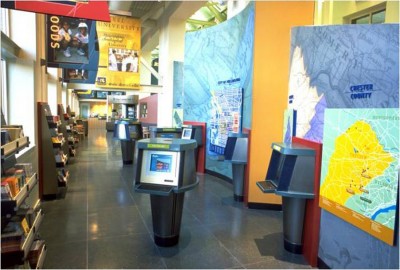System elements
A wayfinding system has many parts that fit together, including colours, typography, shapes, logos, materials and nomenclature.
Gateway signs define entry to a distinct place, with its own identity. Regional gateways may apply to a province, county, heritage area or economic zone (e.g. industrial or commercial corridor). City gateways, which identify a city or town, may lead to district and neighbourhood gateways (e.g. Chinatown) and area identification gateways for less defined areas with distinct culture or commerce (e.g. fashion district) or political importance.
The aforementioned vehicular wayfinding signs are accompanied by pedestrian wayfinding signs, maps and directories. Of course, street name signs, regulatory signs, street furniture, public art, civic banners and informational kiosks also support the notion of an overall wayfinding system.
Getting started
A great deal of preparation is required before establishing a wayfinding plan and unveiling a design concept.
A new sign system, like a bridge or a highway, will affect a number of stakeholder constituencies. Signmakers will benefit if these constituencies are consulted from the outset of a project. They may include a steering committee, management committees, task forces and general stakeholders, such as political and community leaders, funding agencies and the media.
The project team will refine the project’s scope and strategic approach, which may lead to preliminary design descriptions and recommendations. The planning process will include research of best practices, pedestrian and vehicular circulation routes, field conditions and existing sign messaging protocols, as well as surveys of residents, visitors and other stakeholders, before outlining a strategy and early design concept report.

Wayfinding systems include not only signs, but also informational kiosks, maps, directories and other supportive elements.
There is often a great deal of pressure to complete a wayfinding program with one project, but there are many advantages to a multi-stage approach. Developing the program in one location, for example, allows a ‘trial run’ for approval, fabrication and implementation and testing.
System financing
It is also important for signmakers that the process secures financing. Politicians and community leaders can help secure support and defend decisions. Leading sources of funds include grants, donations, business improvement areas (BIAs) and government funds at the municipal, provincial and/or federal level.
In Calgary, for example, a new downtown wayfinding system (see Sign Media Canada, July 2013, page 38) is primarily being funded through downtown improvement and beltline community investments. These funds are generated through downtown licensing fees and developer contributions that are earmarked for public-space improvement projects.
In Toronto, meanwhile, Kramer Design Associates (KDA) and Astral Out-of-Home have integrated a program under city oversight where commercial advertising is used to fund street furniture and wayfinding signage.
Meeting regulations
Another challenge is managing the regulatory framework. One of the reasons for the recent success of large-scale urban wayfinding systems is many governments have updated their codes over the past 20 years, but roadblocks can still exist.
The unfortunate tendency of sign codes is to specify blanket rules whether signs are in urban, suburban or rural locations. In some cases, for example, codes require wayfinding signs to be too large or too far separated from their points of reference. These regulations may focus on the needs of drivers on roads with high speed limits, but are mismatched for low-speed, pedestrian-oriented areas.
In other cases, codes require gateway signs to be too small and dim. These zoning codes may be designed to limit advertising, but they can lead to legibility issues for people trying to find destinations.
While signmakers might seek a variance or legal exception for one or a few signs, a citywide wayfinding program may require developing a whole new sign code, based on analysis of specific conditions, sound research, case studies and observations of other jurisdictions’ successful regulatory framework. Further, variances often undermine the validity of a code and can make it harder to expand a program over time.





